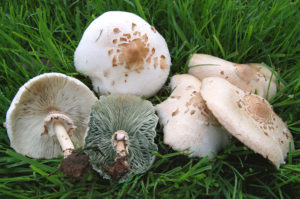
Every winter as I wander along my usual hiking trails it seems that I see the same mushrooms popping up in exactly the same place. Do mushrooms require a certain kind of substrate? —Nicki in San José
“On moonlit nights the fairies come out and dance in the forest; where they dance in circles, mushrooms pop up. When the fairies rest they sit on mushrooms; these are the ones that are good to eat. But toads also come out and sit on mushrooms, these are poisonous ones—the toadstools.”
At least this is how I remember a folktale I read once that explained the mysterious appearance of mushrooms and toadstools. Scientists, who generally can’t see fairies, say there is actually no difference between toadstools and mushrooms; they’re both fungi. But Nicki, it’s definitely no coincidence that you’re seeing mushrooms in exactly the same place year after year. This has to do with their biology. What we call a mushroom or toadstool is really the fruiting body of an often much larger organism. That organism—a type of fungus—lives underground.
Mushrooms reproduce by spores and one species of large mushroom, the artist’s conk, can spew 30 billion spores per day! Yes, I said 30 billion. Even I had to double-check that fact. Another kind can shoot out 31,000 spores per second! These spores are ultra-lightweight (duh!) and can drift up into the stratosphere—13 miles high. Scientists hypothesize that the sheer number of spores released in rain forests, and even in temperate forests, may increase rainfall. Sugars on the surface of the spores attract water molecules that, as they collect, become droplets, clouds, and eventually rain. Fungi literally make it rain! But I digress.
Most of these spores never germinate, but some manage to fall and settle in the perfect circumstances where they grow into white stringy rootlike things called hyphae (a mass of hyphae is a mycelium). These fibrous threads feed on dead organic material. Able to break down what other organisms cannot, they are earth’s best recyclers. Without them we might be up to our necks in sawdust.
Mycelia that germinate from spores are haploid, meaning each one has only half the genetic material needed by the next generation. They’re not really male or female, so let’s just call them mycelial mates. When two compatible hyphae meet underground, they join together to form a full genetic complement. And when conditions are optimal—the right amount of rain, a bit of a cold snap—those fruiting bodies we call mushrooms sprout up out of the ground. Picking a mushroom therefore is no more harmful to the organism than picking an apple is to the tree. The mycelium remains intact below, continuing to spread underground and ready to produce more mushrooms, year after year.
So, Nicki, that is why mushrooms grow in the same location. Some require a specific substrate and others are generalists, meaning almost any place with decaying plant matter will do. I’m not mushroom-phobic nor am I mushroom-philic, but I do adhere to that old adage, “There are old mushroom eaters and there are bold mushroom eaters but there are no old, bold mushroom eaters.”
I have learned about two mushrooms in the Bay Area that are easy to identify, taste good, and will not kill me: chanterelles and inky caps.
Like many fungi, chanterelles form a symbiotic, mutualistic relationship with trees. Chanterelle hyphae coat the tree’s root hairs, facilitating uptake of nutrients (especially phosphorus) in exchange for sugars the tree makes via photosynthesis. In California, chanterelles often form these relationships with oak trees. Some of my friends have closely guarded ultra-secret woodlands where they find this most delicious of mushrooms year after year. What they’re really guarding so jealously is a productive symbiosis.
Inky caps, on the other hand, appear to be generalists. I’ve found them on horse droppings and once even bursting up through concrete! They often grow in tight groups. When young, they have elongated, bullet-shaped, shaggy caps; and they develop black gills as they age. Their other common name is “shaggy mane.” But their coolest trick is that they deliquesce (liquefy) just like the Wicked Witch of the West in Oz. I love saying that word—deliquesce. They basically digest themselves into a slimy black puddle, which some in the past may have used as ink. If you drink alcohol within two days before or after eating one species, Coprinopsis atramentaria, you can fall ill. You won’t die but you will wish you had forgone that glass of wine and stuck with just the mushrooms.




